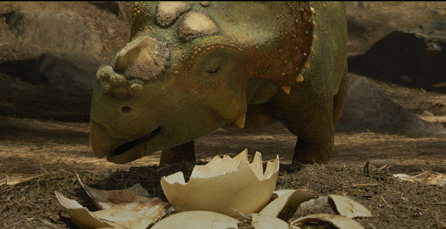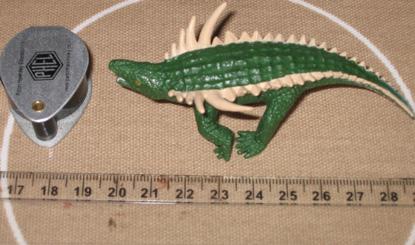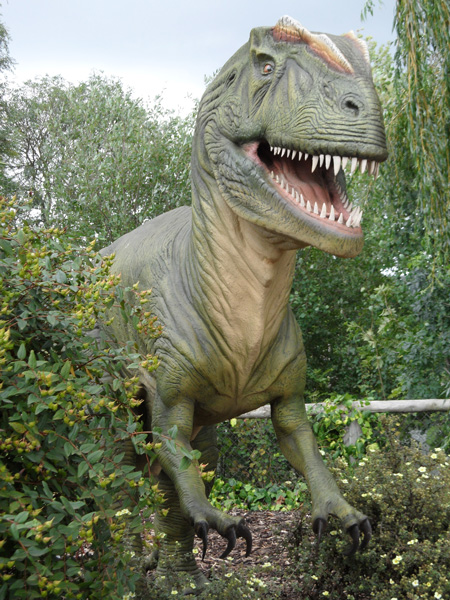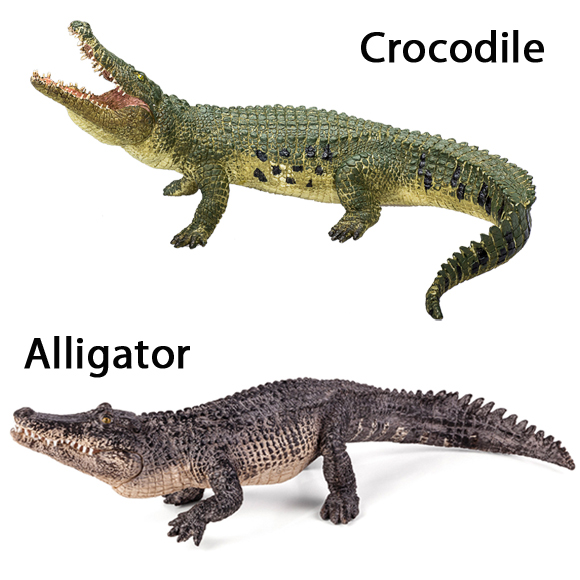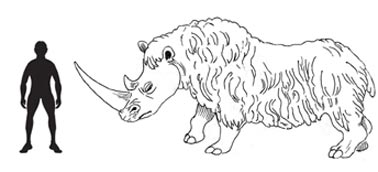Australopithecus sediba May be the Ancestor of Modern Humans
Two fossils, one of a female, one of a young male discovered in South Africa in 2008, may provide scientists with clues to our species origins – H. sapiens. Although the brain may have been not much bigger than a chimpanzees, the fossilised bones indicate an upright walking gait, and the ability to grip and hold tools.
Australopithecus sediba
The fossilised remains of two human-like creatures who probably fell to their deaths, found in South Africa could redraw the map of human evolution and provide scientists with vital information regarding the origins of our own species. The 1.9 million-year-old specimens were formally described last year and given the species name Australopithecus sediba, the name means “southern ape from the natural spring” a reference to the geological formation in South Africa were the fossils were found amongst many other prehistoric animal bones.
The international research team including scientists from the University of Witwatersrand (Johannesburg) and the University of Zurich have carried out a much more thorough analysis of the specimens and have published a number of papers detailing their research, suggesting that A.sediba may represent an important link in the ape to human evolutionary tree.
Co-author of the scientific papers, Professor Lee Berger (University of Witwatersrand) stated:
“We have examined the critical areas of anatomy that have been used consistently for identifying the uniqueness of human beings. Any one of these features could have evolved separately, but it is highly unlikely that all of them would have evolved together if A. sediba was not related to our lineage.”
Professor Lee Berger with the Cranium of A. sediba
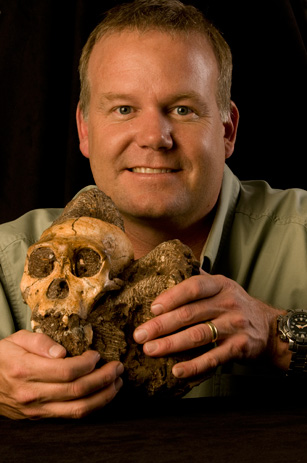
Picture credit: Witwatersrand University
A national competition was launched to find a suitable nickname for the fossilised juvenile. This competition helped raise awareness of the importance of this South African discovery. To read about the competition and to discover the winner: Ancient Hominid Fossil From “Human Cradle” Named.
The research team are making a very big claim. A number of scientists have proposed fossil specimens as being transitional between the Australopithecines and the ancestral line that led to fossil humans.
Tracing the Human Family Tree
The current, most widely accepted hypothesis holds that modern humans can trace their ancestry back to a creature known as Homo erectus which lived more than a million years ago. This animal, according to many palaeoanthropologists, may in turn have had its origins in more primitive hominins, as they are known, such as Homo habilis or Homo rudolfensis.
The contention now made for A. sediba is that, although older than its “rivals”, some of its anatomy and capabilities were more advanced than these younger forms. Put simply, it is a more credible ancestor for H. erectus, the research team propose.
Although very different to ourselves, modern humans, the importance of determining an ancestor of H.erectus cannot be underestimated. This particular hominid probably evolved in Africa from an African ancestor, H. erectus was the first “human-like” creature to become widespread. The best fossils of H. erectus have come from Asia and it may have been the “longest lived” human species with some scientists suggesting that may have been on planet Earth from around 1.8 million years ago to just fifty thousand years ago.
The A. sediba specimens were unearthed at Malapa in the famous Cradle of Humankind World Heritage Site, just to the north-west of Johannesburg. The fossils were found in a pit, a depression left in the ground after the roof of a cave had collapsed. These pits are common in the area, which is dominated by dolomitic limestone and a number of caves and cave complexes are known.
The fossil layers accumulated at the base of these shafts which may have operated as death traps. The sediments were cemented by lime-saturated water and were sealed with flowstones. The excellent preservation of the fossils implies a fast deposition and only minor transportation of the bodies of the animals including the remains of these two specimens of A. sediba.
Professor Berger with the Partial Remains of One Specimen Laid Out

Ancient fossils.
Picture credit: Brett Eloff (Witwatersrand University)
One hypothesis put forward by the research team is that in the search for water, animals might have fallen into the cave. Predators could have been attracted to the smell of decomposing bodies and suffered the same fate. Subsequent rainfalls washed the intact bodies more deeply into the cave where they were submerged in an underground lake. It is these conditions that enabled the preservation of the fragile fossil bones.
Adult Female and Juvenile Male
Identified as an adult female and a juvenile male, the two individuals were quite possibly mother and son. What seems certain is that they died together in some tragic accident that saw them either fall into the cave complex or become stuck in it. After death, their bodies were washed into the underground lake and cemented in time along with the remains of many other animals that got trapped in the same way; including some creatures that were probable predators of A. sediba – large hyenas and big cats.
One important area of study has involved a more accurate dating of the strata within which the fossils were found. The latest dating technologies were applied to the sediments encasing the fossils. Whereas original estimates had put the age of the remains at somewhere between 1.78 and 1.95 million years old, the new analysis has narrowed this window of uncertainty to just 3,000 years. The new age is now between 1.977 and 1.98 million years old. The refined dating is important, says the team, because it puts A. sediba deep enough in time to be a realistic ancestor to H. erectus.
Dr Robyn Pickering, from the University of Melbourne, Australia, who led the dating team and one of a number of Australian based scientists who worked on this project, commented:
“This is a very interesting time in human evolution because it is when we think we should be seeing the beginnings of our genus, Homo. Previously, we’ve had very few fossils from this time period, so the sediba fossils are remarkable in that they are so complete.”
One of the characteristics that distinguishes modern humans from other primates is the size and structure of our brains. Fossils of H.erectus show a significant increase in brain size when compared to older primate fossils such as H. rudolfensis. Estimates for the cranial capacity of H. erectus vary but a brain size of around 1,000 cubic centimetres in volume has been stated. A high-resolution X-ray scan of the male specimen’s skull has produced a virtual cast of its braincase. This was carried out at the European Synchrotron Radiation Facility in Grenoble.
From this, the researchers estimate an adult A. sediba’s brain to have been about 440 cubic centimetres in volume, about the size of a medium grapefruit. This is smaller than much older fossils in the record such as the famous “Lucy” specimen, Australopithecus afarensis (3.2 million years), but, intriguingly, the shape is more human-like, especially at the front. This may hint at the start of the re-organisation of the brain that would be necessary to make us what we are today with our large neocortex.
The Complicated Human Evolutionary Tree

Plotting the family history.
Picture credit: Peter Schmid (University of Zurich)
Due to the paucity of the fossil record, determining the origins of our species and our direct ancestors is extremely difficult, but these new fossils from South Africa may shed further light on this aspect of evolution.
The pelvic area also indicates very human-like characteristics. The pelvis is short and broad just like a human pelvis. A more ancient creature like Lucy has a flatter and more flaring pelvis, very ape-like in shape. A popular idea has been that the modern human pelvis evolved in tandem with the gradual growth in brain volume, facilitating the birth of babies with bigger heads. A. sediba gives the lie to this theory, says the team, because it had a modern-looking pelvis while possessing a small brain.
The right-hand of the female is very nearly complete. It is looks far more like a modern human hand than an ape hand. Its fingers are shorter relative to the thumb than in a chimpanzee. Yet, it appears to have possessed powerful muscles for grasping, suggesting A. sediba spent a lot of time clambering through the branches of trees, indicating an arboreal habit. The research team also argues that the dexterity would have been there to make simple tools. Hand axes and other stone tools have been found in association with H. erectus fossil remains.
The lower foot bones also reveal some intriguing information about these creatures. The ankle joint is mostly human-like in form and there is some evidence for a human-like arch and Achilles tendon. However, A. sediba possessed an ape-like heel and lower tibia, or shin bone (not as elongated as in more modern human species). The scientists think this combination may have led to a distinctive type of walk when the creature was not climbing in trees. This could suggest a transition between an entirely arboreal existence and a move towards spending more time out of the trees.
Whatever the correctness of the analysis, the creature certainly has a fascinating mix of features – some archaic, some modern, a mix of evolutionary traits. A number of scientists have described these fossils as fascinating and very well preserved.
Dr William Harcourt-Smith from the American Museum of Natural History in New York, commented:
“One lineage of Australopithecus almost certainly led into the first member of our own genus called Homo, and from them eventually emerged modern humans. But some of them are side branches, and we’re trying to work out which ones are and which ones aren’t – and that’s why this finding is so important. In many ways, these fossils are the ‘smoking gun’ just before the emergence of our own genus.”
Professor Chris Stringer, from London’s Natural History Museum, a world renowned expert on the origins of our own species stated:
“This isn’t the end of the story. What may be happening is that there were several Australopithecine forms all evolving human-like features in parallel as they turned to meat-eating and tool-making and moving greater distances.”
He went onto add:
“The question now is to pull out of this mess which one is really the ancestor of the genus Homo. We know there are more remains to come from this incredible site. Let’s see if other individuals also show this mix of features.”



